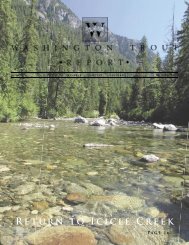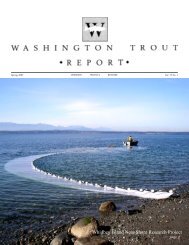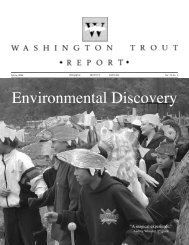Seafood Watch
Pacific Salmon - Wild Fish Conservancy
Pacific Salmon - Wild Fish Conservancy
- No tags were found...
You also want an ePaper? Increase the reach of your titles
YUMPU automatically turns print PDFs into web optimized ePapers that Google loves.
<strong>Seafood</strong> <strong>Watch</strong>® Wild Pacific Salmon Report October 8, 2010<br />
Chinook Salmon (Oncorhynchus tshawytscha)<br />
Chinook salmon, also called king or spring salmon, is the largest of the Pacific salmon species,<br />
with adult fish commonly exceeding 30 pounds. Chinook salmon is Alaska’s state fish and<br />
represents an important commercial and recreational species throughout the northern Pacific<br />
(Delaney 1994).<br />
Distribution<br />
In North America, the natural range of freshwater habitats for Chinook salmon stretches from the<br />
Ventura River in California northward to Kotzebue Sound in Alaska (Figure 1.1) (DFO 2001).<br />
Once at sea, Chinook may swim anywhere from the U.S.-Mexico border to the Chukchi Sea off<br />
of Alaska.<br />
On the Asian side of the Pacific, Chinook occur in freshwater from the Anadyr River area of<br />
Siberia (64 degrees north) southward to Hokkaido, Japan. In marine waters, they are found in the<br />
Sea of Japan, Bering Sea, and Sea of Okhotsk (Delaney 1994, Froese and Pauly 2004).<br />
ESUs<br />
In the contiguous U.S., 17 ESUs of Chinook salmon have been identified:<br />
• Sacramento River Winter-run<br />
• Upper Columbia River Spring-run<br />
• Snake River Spring/Summer-run<br />
• Snake River Fall-run<br />
• Puget Sound<br />
• Lower Columbia River<br />
• Upper Willamette River<br />
• Central Valley Spring-run<br />
• California Coastal<br />
• Central Valley Fall and Late Fall-run<br />
• Upper Klamath-Trinity Rivers<br />
• Oregon Coast<br />
• Washington Coast<br />
• Middle Columbia River Spring-run<br />
• Upper Columbia River Summer/Fall-run<br />
• Southern Oregon and Northern California Coastal<br />
• Deschutes River Summer/Fall-run<br />
As of June 2004, two of these 17 ESUs (Sacramento River Winter-run and Upper Columbia<br />
River Spring-run) were listed as Endangered Species. In addition, seven of the 17 ESUs were<br />
listed as Threatened Species, and one ESU (Central Valley Fall and Late Fall-run) was<br />
designated a Species of Concern (NMFS 2004a).<br />
In Alaska, Chinook salmon are managed on a regional basis, rather than dividing the species into<br />
ESUs. The four overarching regions in Alaska are: Southeast Alaska, Central Region, Westward<br />
Region, and Arctic-Yukon-Kuskokwim Region. Chinook salmon are predominantly harvested in<br />
17






